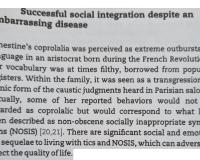In 1825, Paris physician Jean Marc Gaspard Itard assessed a French noblewoman in her twenties who, from the age of seven, had ‘ticked and blasphemed‘. She was one of ten people with similar symptoms described in an article by Itard.
Sixty years later, in 1885, Georges Gilles de la Tourette – after whom Tourette syndrome was later named – published an account of nine patients, all of whom had involuntary movements and/or vocalisations. One of these was the same woman.
She was known as the ‘Marquise de Dampierre’ in medical journals documenting her case. Her real identity was unknown for a long time. She was Ernestine Émilie Prondre de Guermantes, who when she married, became Comtesse Picol de Dampierre.
At the time, Itard recorded her swearing tics, which would today be recognised as coprolalia, as being ‘obviously in stark contrast to the lady’s background, intellect, and refined manners’. Other descriptions of her referred to her being ‘well-bred’, ‘respectable’, but behaving inappropriately at society events, using ‘filthy’ language, which she had ‘borrowed from popular registers’ ie. from the common people.
She was noticed because her behaviour did not match her social standing. Aristocrats (perhaps especially aristocratic women) are expected to be polite and respectable, not to call out ‘fucking pig’, as Madame Dampierre often did. Had she been a peasant or working-class woman, it is highly unlikely that her behaviour would have attracted the attention of doctors. It would not have been seen as at odds with their social standing.
Neurodivergence is usually measured by behaviour, and behaviour is often measured against yardsticks heavily determined by class, as well as by other factors such as gender (physicians thought that her convulsions would be cured by her marriage, but this turned out to be a forlorn hope).
From the very beginnings of its modern study, neurodiversity has been a class issue.


